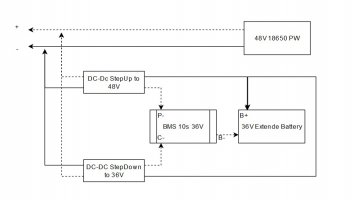cadric
Member
- Joined
- May 3, 2018
- Messages
- 110
Hi,
ChrisD gave me a hint last year how he combined a 36V Battery to the 48V Main Battery System.
The short description is using a dc stepup module for loading the 48V Battery with the 36V one.
I thought about it and wonder how to load that 36V battery again.
I don't think that connection a step up in one direction and a step down module in the other direction is the right way, at least not without switching between them.

So another Idea was to find a bidirectional converter module, but up to now I did not find one fitting the needs of 36V to 48 Volt.

Does anyone have an idea of such an equipment that can deliver maybe 1500W?
Or any other solution that fits the needs to combine 36V and 48 Volt Batteries?
I also asked Chris via PM for a description of his system, maybe that already would fullfill the requirements, but I'm still curious about any other idea.
thanks in advance
cadric
ChrisD gave me a hint last year how he combined a 36V Battery to the 48V Main Battery System.
The short description is using a dc stepup module for loading the 48V Battery with the 36V one.
I thought about it and wonder how to load that 36V battery again.
I don't think that connection a step up in one direction and a step down module in the other direction is the right way, at least not without switching between them.

So another Idea was to find a bidirectional converter module, but up to now I did not find one fitting the needs of 36V to 48 Volt.

Does anyone have an idea of such an equipment that can deliver maybe 1500W?
Or any other solution that fits the needs to combine 36V and 48 Volt Batteries?
I also asked Chris via PM for a description of his system, maybe that already would fullfill the requirements, but I'm still curious about any other idea.
thanks in advance
cadric



